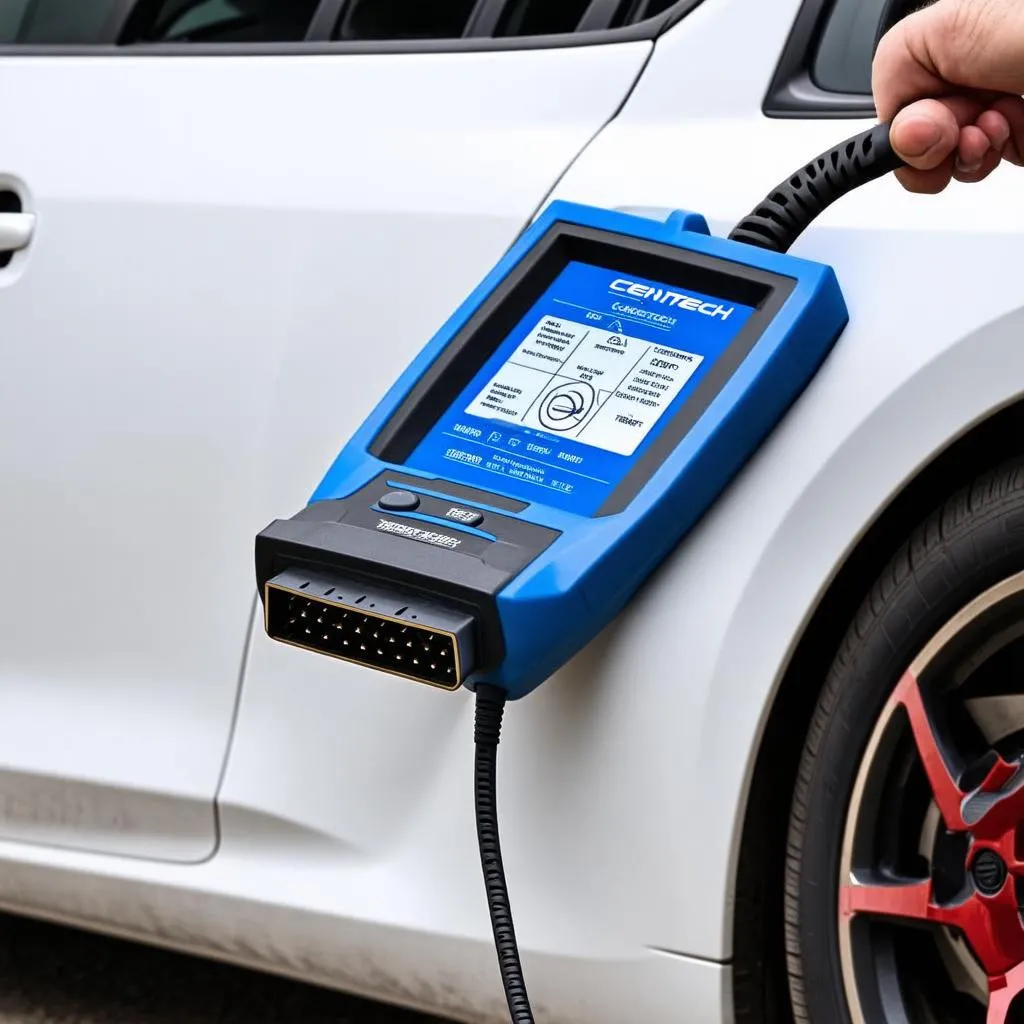Have you ever stared at your car’s dashboard, baffled by a blinking light or cryptic error message? It can feel like your car is speaking a foreign language! That’s where the Centech Professional Scan Tool comes in – it’s like having a universal translator for your vehicle. This powerful device can help you diagnose problems, understand error codes, and even monitor your car’s performance in real-time.
But with great power comes, well, the need to know how to use it! In this comprehensive guide, we’ll demystify the Centech Professional Scan Tool, providing you with all the knowledge you need to become a confident DIY mechanic.
Understanding the Power of the Centech Scan Tool
Before we dive into the “how-to,” let’s explore why the Centech Professional Scan Tool is such a game-changer for car owners and mechanics alike.
From a mechanic’s perspective, this tool is an absolute lifesaver. Imagine easily pinpointing a faulty sensor in a BMW X5’s complex electrical system or diagnosing a tricky transmission issue in a Ford F-150. The Centech Scan Tool provides the data needed to make accurate repairs, saving both time and money.
For the everyday car enthusiast, this tool offers a window into the inner workings of their vehicle. It empowers you to understand what those pesky dashboard lights mean, monitor vital engine parameters, and even reset basic maintenance reminders.
Financially speaking, the Centech Scan Tool can be a real boon. Take John from California, for instance. His check engine light illuminated, prompting a trip to his local mechanic. The mechanic quoted him a hefty sum just for the diagnostic test! John, being a bit of a techie, decided to invest in a Centech Scan Tool instead. He quickly found the issue – a faulty oxygen sensor – and replaced it himself for a fraction of the cost. John not only saved money but also gained the satisfaction of fixing his car independently.
Getting Started with Your Centech Professional Scan Tool
Connecting to Your Vehicle’s OBD-II Port
The first step is connecting the Centech Scan Tool to your vehicle’s OBD-II port. This port is usually located under the dashboard on the driver’s side. Simply plug the tool’s connector into the port, and you’re ready to go!
Navigating the User Interface
The Centech Scan Tool features an intuitive interface that makes it easy to find the information you need. The menu is typically structured around key functions:
- Read Codes: This option retrieves and displays any stored Diagnostic Trouble Codes (DTCs), which indicate specific areas of concern within your vehicle’s systems.
- Live Data: Allows you to view real-time data streams from various sensors, including engine RPM, coolant temperature, and oxygen sensor readings.
- Special Functions: Access advanced functions like resetting the check engine light, performing component activations (such as ABS module bleeding), or accessing module-specific diagnostics.
Decoding Diagnostic Trouble Codes (DTCs)
When your Centech Scan Tool retrieves a DTC, it can feel like deciphering a secret code. Fear not! Here’s how to break it down:
DTCs follow a standardized format, such as “P0301.”
- The first letter (e.g., “P”) indicates the system: “P” stands for Powertrain, “B” for Body, “C” for Chassis, and “U” for Network & Communication.
- The next two digits (e.g., “03”) signify a specific subsystem or function.
- The final two digits (e.g., “01”) pinpoint the exact problem within that subsystem.
For example, “P0301” translates to “Powertrain – Cylinder 1 Misfire Detected.”
Always consult your vehicle’s repair manual or a reputable online database for accurate DTC definitions and troubleshooting steps.
Common Uses for the Centech Professional Scan Tool
1. Diagnosing Engine Issues
The Centech Scan Tool can help you quickly pinpoint common engine problems, such as misfires, oxygen sensor failures, or issues with the mass airflow sensor.
2. Troubleshooting Transmission Problems
Is your transmission slipping or behaving erratically? The Centech Scan Tool can access transmission-related data, helping you identify potential problems with solenoids, sensors, or fluid pressure.
3. Diagnosing ABS and Airbag Issues
Modern vehicles are packed with safety systems like ABS and airbags. The Centech Scan Tool can retrieve DTCs related to these systems, allowing you to address potential safety concerns.
FAQs about the Centech Professional Scan Tool
Q: Will this scan tool work on my car?
A: The Centech Professional Scan Tool is designed to work with most vehicles manufactured after 1996 that are equipped with the standard OBD-II port.
Q: Can I use the Centech Scan Tool to reset my oil light?
A: Yes, many Centech Scan Tool models offer the functionality to reset basic maintenance reminders, including oil life indicators.
Q: I’m getting a “Link Error.” What does it mean?
A: A “Link Error” usually indicates a problem with the connection between the scan tool and your vehicle’s OBD-II port. Double-check that the connector is properly seated, the ignition is turned on, and there are no damaged wires.
Exploring Further: Related Resources
To delve deeper into specific Centech Scan Tool models or related topics, check out these informative articles:
- Centech 60794 vs Autel: A Head-to-Head Comparison
- Unlocking the Power of Autel Cen-Tech OBDII Scanners
Need Expert Help with Your Centech Scan Tool?
We understand that navigating the world of automotive diagnostics can be daunting. If you need assistance setting up your Centech Professional Scan Tool or interpreting those cryptic error codes, our team of automotive experts is just a message away.
Contact us on WhatsApp at +84767531508 for 24/7 support. We’re here to help you become a more confident and empowered car owner!
Ready to Take Control of Your Car’s Health?
The Centech Professional Scan Tool puts the power of professional-grade diagnostics right in your hands. No longer will you be intimidated by dashboard lights or left wondering what’s happening under the hood. Armed with this tool and the knowledge from this guide, you’ll be well on your way to becoming a true master of your vehicle’s maintenance and repair.



